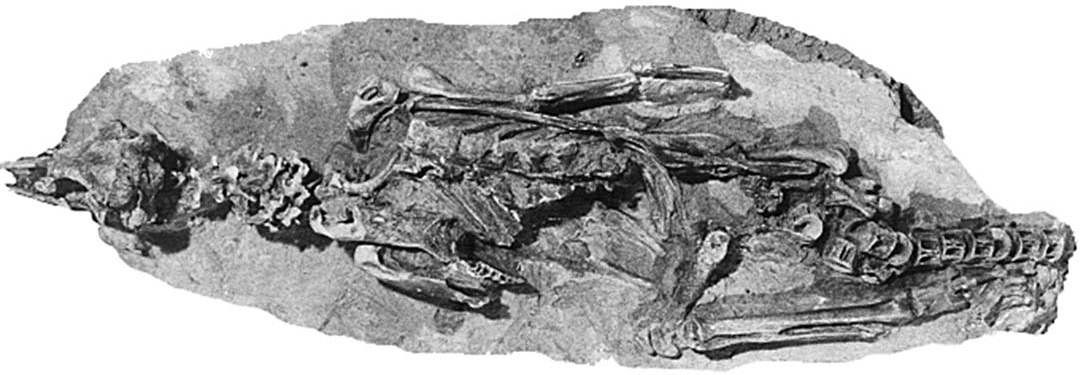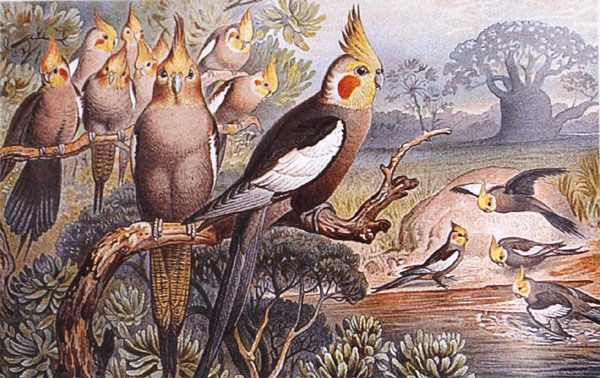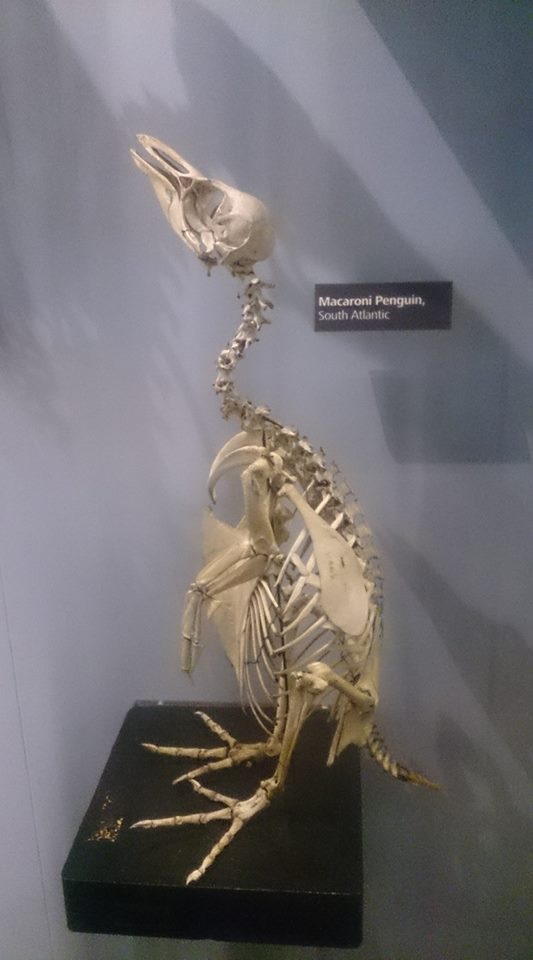|
Crest (feathers)
The crest is a prominent feature exhibited by several bird and other dinosaur species on their heads. It is distinct from features such as casques and cockscombs - sometimes erroneously referred to as "crests", which are bony and fleshy structures respectively. The crest is made up of semiplume feathers: a long rachis with barbs on either side. These are plumulaceous feathers, meaning that they are soft and bendable. In birds, these semiplumes are common along the head, neck, and upper back, and may be used for buoyancy and sensing vibrations. Crests on birds are generally used for display purposes. Cockatoos and their smaller cousins, cockatiels, are part of the parrot family Cacatuidae found in Australia, the Bismarck Archipelago and the Philippines, and are probably the most recognizable birds to feature crests. Cockatoos and cockatiels possess crests which may be raised or lowered at will. Their crests are used to communicate with fellow members of their species, or as a fo ... [...More Info...] [...Related Items...] OR: [Wikipedia] [Google] [Baidu] |
Balearica Regulorum Portrait 3
The bird genus ''Balearica'' (also called the crowned cranes) contains two extant species in the crane family Gruidae: the black crowned crane (''B. pavonina'') and the grey crowned crane (''B. regulorum''). The species today occur only in Africa, south of the Sahara Desert, and are the only cranes that can nest in trees. This habitat is one reason the relatively small ''Balearica'' cranes are believed to closely resemble the ancestral members of the Gruidae. Like all cranes, they eat insects, reptiles, and small mammals. Taxonomy The genus ''Balearica'' was erected by the French zoologist Mathurin Jacques Brisson in 1760 with the black crowned crane (''Balearica pavonina'') as the type species. The name is from the Latin ''Baliaricus'' for "of the Balearic Islands". The crane family (Gruidae) is divided into the subfamily Gruinae of typical cranes and the subfamily Balearicinae of crowned cranes. Extant species Fossil record Crowned cranes seem to have been more widesp ... [...More Info...] [...Related Items...] OR: [Wikipedia] [Google] [Baidu] |
Citron-crested Cockatoo
The citron-crested cockatoo (''Cacatua sulphurea citrinocristata'') is a medium-sized cockatoo with an orange Crest (feathers), crest, dark grey beak, pale orange ear patches, and strong feet and claws. The underside of the larger wing and tail feathers have a pale yellow color. The eyelid color is a very light blue. Both sexes are similar. Females have a coppered colored eye where as the male has a very dark black eye. The smallest of the yellow-crested cockatoo subspecies, it is Endemism in birds, endemic to Sumba in the Lesser Sunda Islands in Indonesia. The diet consists mainly of seeds, buds, fruits, nuts and herbaceous plants. In 2022, Birdlife International recognized the citron-crested cockatoo as a separate species, ''Cacatua citrinocristata''. Conservation status The citron-crested cockatoo is a critically endangered bird whose population has declined due to habitat loss and illegal trapping for the cage-bird trade. A 1993 survey of Sumba estimated the species' numbe ... [...More Info...] [...Related Items...] OR: [Wikipedia] [Google] [Baidu] |
Snood (anatomy)
The turkey is a large bird in the genus ''Meleagris'', native to North America. There are two extant turkey species: the wild turkey (''Meleagris gallopavo'') of eastern and central North America and the ocellated turkey (''Meleagris ocellata'') of the Yucatán Peninsula in Mexico. Males of both turkey species have a distinctive fleshy wattle, called a snood, that hangs from the top of the beak. They are among the largest birds in their ranges. As with many large ground-feeding birds (order Galliformes), the male is bigger and much more colorful than the female. Native to North America, the wild species was bred as domesticated turkey by indigenous peoples. It was this domesticated turkey that later reached Eurasia, during the Columbian exchange. In English, "turkey" probably got its name from the domesticated variety being imported to Britain in ships coming from the Turkish Levant via Spain. The British at the time therefore associated the bird with the country Turkey a ... [...More Info...] [...Related Items...] OR: [Wikipedia] [Google] [Baidu] |
Crested Penguin
The term crested penguin is the common name given collectively to species of penguins of the genus ''Eudyptes''. The exact number of species in the genus varies between four and seven depending on the authority, and a Chatham Islands species became extinct in recent centuries. All are black and white penguins with yellow crests, red bills and eyes, and are found on Subantarctic islands in the world's southern oceans. All lay two eggs, but raise only one young per breeding season; the first egg laid is substantially smaller than the second. Taxonomy The genus ''Eudyptes'' was introduced by the French ornithologist Louis Jean Pierre Vieillot in 1816; the name is derived from the Ancient Greek words ''eu'' meaning "fine", and ''dyptes'' meaning "diver". The type species was designated as the southern rockhopper penguin by George Robert Gray in 1840. Six extant species have been classically recognised, with the recent splitting of the rockhopper penguin increasing it to seven. Conver ... [...More Info...] [...Related Items...] OR: [Wikipedia] [Google] [Baidu] |
Comb (anatomy)
A comb is a fleshy growth or crest on the top of the head of some gallinaceous birds, such as domestic chickens. The alternative name cockscomb (with several spelling variations) reflects the fact that combs are generally larger on cock birds than on hens. The comb is one of several fleshy protuberances on the heads of chickens, the others being the wattles and earlobes, which collectively are called caruncles. In turkeys, the caruncles are the fleshy nodules on the head and throat. Chicken combs are most commonly red, but may also be black or dark purple in breeds such as the Silkie or the Sebright. In other species the color may vary from light grey to deep blue or red. The comb may be a reliable indicator of health or vigor and is used for mate-assessment in some poultry species. Types of chicken comb Comb shape varies considerably depending on the breed or species of bird. Of the many types and shapes seen in chicken cocks the principal ones are: * the single comb, ... [...More Info...] [...Related Items...] OR: [Wikipedia] [Google] [Baidu] |
Great Crested Grebe
The great crested grebe (''Podiceps cristatus'') is a member of the grebe family of water birds noted for its elaborate mating display. Taxonomy The great crested grebe was formally described by the Swedish naturalist Carl Linnaeus in 1758 in the tenth edition of his ''Systema Naturae'' under the binomial name ''Colymbus cristatus''. The great crested grebe is now the type species of the genus ''Podiceps'' that was erected by the English naturalist John Latham in 1787. The type locality is Sweden. The scientific name comes from Latin: the genus name ''Podiceps'' is from , "vent" and , "foot", and is a reference to the placement of a grebe's legs towards the rear of its body; the species name, ''cristatus'', means "crested". Three subspecies are recognised: * ''P. c. cristatus'' (Linnaeus, 1758) – Eurasia * ''P. c. infuscatus'' Salvadori, 1884 – Africa * ''P. c. australis'' Gould, 1844 – Australia, Tasmania, South Island of New Zealand Description The great creste ... [...More Info...] [...Related Items...] OR: [Wikipedia] [Google] [Baidu] |
Hoopoe
Hoopoes () are colourful birds found across Africa, Asia, and Europe, notable for their distinctive "crown" of feathers. Three living and one extinct species are recognized, though for many years all of the extant species were lumped as a single species—''Upupa epops''. In fact, some taxonomists still consider all three species conspecific. Some authorities also keep the African and Eurasian hoopoe together but split the Madagascar hoopoe. The Eurasian hoopoe is common in its range and has a large population, so it is evaluated as Least Concern on The IUCN Red List of Threatened Species. However, their numbers are declining in Western Europe. Conversely, the hoopoe has been increasing in numbers at the tip of the South Sinai, Sharm el-Sheikh. There are dozens of nesting pairs that remain resident all year round. Taxonomy The genus ''Upupa'' was introduced in 1758 by the Swedish naturalist Carl Linnaeus in the tenth edition of his ''Systema Naturae''. The type species is the ... [...More Info...] [...Related Items...] OR: [Wikipedia] [Google] [Baidu] |
Cockatiel
The cockatiel (; ''Nymphicus hollandicus''), also known as weiro (also spelt weero), or quarrion, is a medium-sized parrot that is a member of its own branch of the cockatoo family endemic to Australia. They are prized as household pets and companion parrots throughout the world and are relatively easy to breed. As a caged bird, cockatiels are second in popularity only to the budgerigar. The cockatiel is the only member of the genus ''Nymphicus''. It was previously unclear whether the cockatiel was a crested parakeet or small cockatoo; however, more recent molecular studies have assigned it to its own subfamily, ''Nymphicinae''. It is, therefore, now classified as the smallest of the Cacatuidae (cockatoo family). Cockatiels are native to Australia, favouring the Australian wetlands, scrublands, and bushlands. Taxonomy and etymology Originally described by Scottish writer and naturalist Robert Kerr in 1793 as ''Psittacus hollandicus'', the cockatiel (or cockateel) was moved t ... [...More Info...] [...Related Items...] OR: [Wikipedia] [Google] [Baidu] |
Macaroni Penguin
The macaroni penguin (''Eudyptes chrysolophus'') is a species of penguin found from the Subantarctic to the Antarctic Peninsula. One of six species of crested penguin, it is very closely related to the royal penguin, and some authorities consider the two to be a single species. It bears a distinctive yellow crest, and the face and upperparts are black and sharply delineated from the white underparts. Adults weigh on average and are in length. The male and female are similar in appearance; the male is slightly larger and stronger with a relatively larger bill. Like all penguins, it is flightless, with a streamlined body and wings stiffened and flattened into flippers for a marine lifestyle.It has a small eye and is good at seeing. Its diet consists of a variety of crustaceans, mainly krill, as well as small fish and cephalopods; the species consumes more marine life annually than any other species of seabird. These birds moult once a year, spending about three to four weeks asho ... [...More Info...] [...Related Items...] OR: [Wikipedia] [Google] [Baidu] |
Umbrella Cockatoo
The white cockatoo (''Cacatua alba''), also known as the umbrella cockatoo, is a medium-sized all-white cockatoo endemic to tropical rainforest on islands of Indonesia. When surprised, it extends a large and striking head crest, which has a semicircular shape (similar to an umbrella, hence the alternative name). The wings and tail have a pale yellow or lemon color which is exposed when they fly. It is similar to other species of white cockatoo such as yellow-crested cockatoo, sulphur-crested cockatoo, and salmon-crested cockatoo, all of which have yellow, orange or pink crest feathers instead of white. Names The white cockatoo is known as ''ayab'' (plural form: ''ayot'') in the Burmeso language of Papua, Indonesia. Taxonomy The white cockatoo was first described in 1776 by German zoologist Philipp Ludwig Statius Müller. Its species name ''alba'' is a feminine form of the Latin adjective ''albus'' for "white". It lies in the subgenus ''Cacatua'' within the genus ''Cacatua' ... [...More Info...] [...Related Items...] OR: [Wikipedia] [Google] [Baidu] |
Victoria Crowned Pigeon
The Victoria crowned pigeon (''Goura victoria'') is a large, bluish-grey pigeon with elegant blue lace-like crests, maroon breast and red irises. It is part of a genus ( ''Goura'') of four unique, very large, ground-dwelling pigeons native to the New Guinea region. The bird may be easily recognized by the unique white tips on its crests and by its deep 'whooping' sounds made while calling. Its name commemorates the British monarch Queen Victoria. Description The Victoria crowned pigeon is a deep blue-grey colour with a small, black mask. Its feather crest (the signature feature of crowned pigeons other than their size) is conspicuously white-tipped. On the wing coverts is a row of feathers that are a paler blue-gray with maroon tips. These form a distinct wing bar. The chest is a deep purple-maroon color. As in all crowned pigeons, melanism has been observed. The other two crowned pigeons are somewhat superficially similar, but only the western crowned pigeon overlaps in range w ... [...More Info...] [...Related Items...] OR: [Wikipedia] [Google] [Baidu] |




.jpg)
_(16277761817).jpg)


